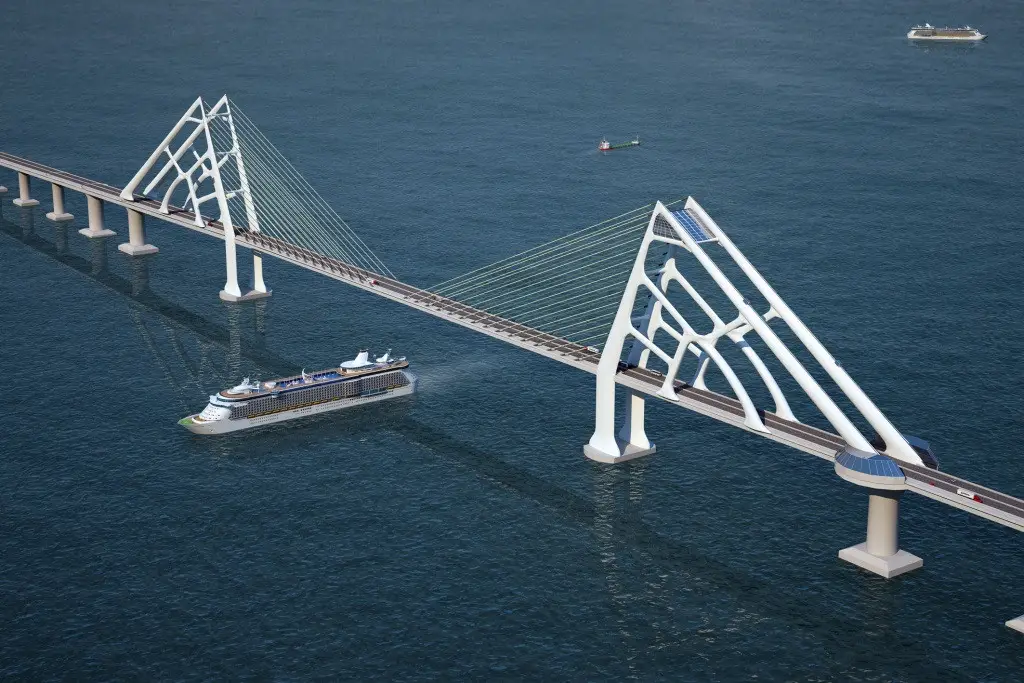The imposing $1.8 billion cable-stayed bridge construction across a span of about 12km will get underway in 2025. Connecting two major Brazilian cities over Bay All Saints’ water body. The specific cities that are designated to be connected are Salvador, which serves as the capital and cultural epicenter of Bahia’s northeastern State. The other city is Itaparica Island in the same bay at coastal port municipality.
The proposed Salvador-Itaparica Bridge will provide direct access to the area. Otherwise would have involved lengthy ferry rides or vast inland detours. It aims at improving tourism as well as commerce between both cities. Hence, boosting economic prosperity of over 10 million residents.
This large-scale infrastructure bridge construction project receives funds from Chinese business investors. Moreover, five years in the making as a public-private partnership. Thus, entailing impressive logistical considerations given record linkage across 19km of open sea water. Nevertheless, feasibility studies have already begun on a long-term project of harnessing the Bay of All Saints in Brazil. Furthermore, bolstering connection between Salvador and metropolitan Itaparica as it ramps up transport systems.
The Future of Transportation: Innovations in Bridge Construction Design
The public-private bridge construction project took five years for development. Salvador–Itaparica bridge construction withstood historical significance in relation to being an infrastructure endeavor after which Brazil is not. As a span involving 12.4 km is expected to be completed in the year 2028, it will become one of the two long bridges over Bay of All Saints. Hence, likely to emerge as longest bridge spanning Latin America. This is second only after Mexico-Panama’s Trans peninsular Viaduct itself twice its length or four times its width.
The actual influence is beyond a bridge itself to include 34km of connecting freeways on each side. Two elaborately designed tunnels through coastal topography and various viaducts constructed in order to suit transportation routes with landscape. A unitary infrastructure constellation collectively strives to create an important new economic conduit between the cities of Salvador and Itaparica. Thus, making tourism development possible by minimizing travel times making travelling easier among other things.
More significantly, the bridge will benefit more than 10 million residents from over 250 municipalities in the Bahia region. This is by reducing travel time and speeding up commercial activity. Moreover, facilitating access to jobs, education, health care along with other crucial services for communities relying on this construction as a gateway between social mobility.
Chinese Consortium Secures Salvador-Itaparica Bridge Construction Project
The competitive contract to construct and operate the Salvador-Itaparica Bridge passed on a consortium composed of two state owned major Chinese corporations. The CCCC, China Communications Construction Company and China Railway 20 Bureau group. They will run it for thirty five years.
Even while conceding a solemn bid of US$ 1.8 billion, the group beat perceptions from five other potential multinational infrastructure developers. Thus, to win rights to handle Brazil’s second longest bridge. Their choice epitomizes the biggest Chinese civil engineering investment in South American infrastructure yet. It also capitalizes on nearly $54 billion in financing that China has allocated for Brazilian transport projects.
The contract, however, was later authorized in November 2020 following delays due to COVID-19 supply chain disruptions pushed building cost up by an estimated $500 million. Indeed, the commitment of Chinese capital secures this symbolic bridge to some extent feared by intimidation risks stalled without financing from being nothing but a lynchpin for Salvador and Itaparica. By doing so, China secures the strategic grounding of Brazilian transport axis for decades.
Commencement of Groundwork for the Salvador-Itaparica Bridge
After long negotiations, Chinese financing and construction contracts are crystallized. This leads to the commencement of laying down important groundwork for building such a mammoth as Salvador-Itaparica Bridge. In January 2024 engineering teams started subsurface test drilling onshore along the preferred infrastructure routes. On-site analysis will determine foundation support capacities and inform design structural blueprints in relation to the geology.
This terrestrial analysis is to be finished by February 2024. Then maritime drilling rigs will sail to the bay floor for making core samples, sonar mapping and computer modelling in order to blueprint a bridge capable of withstanding hostile coastal climate for more than a century. Firms that construct the bridge will also measure in detail ocean currents and wind shear to make it possible precision-engineer its structure as well as cable-stay suspension system according to his natural environment.
This masterful planning phase has been going on for more than a year. The real ground breaking construction of bridge’s foundations and pillars cannot begin until 2025 after rainy season ends. This mega infrastructure project must be systemically assessed in geotechnical and environmental studies to enable it perform its role of nature withstanding for the global trade industry.
Conclusion
Besides the engineering wonder, this project could also mean an economic boom for state Brazil – Bahia. The bridge and connecting highways are projected to create new tourism prospects. Furthermore, enhance thriving commercial trade corridors through the region. This new stream of economic activity and the vital transportation connection between Salvador city, Itaparica island is estimated to potentially contribute as much as 250 municipalities encompassing ~1 million Bahia residents.
The Salvador-Itaparica bridge construction project also symbolizes mounting infrastructure deficits in Brazil and global collaboration to realize such a mega task through FDI. When construction is completed it would turn into a symbol of human spirit and economics rising up both at Bahia as well. The short term of its success will undoubtedly be imposed upon the management abilities and skills. Furthermore, cooperative governance to achieve prosperity inculcated in local communities.


